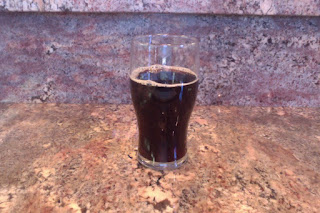This beer was meant to be one big experiment but it soon got out of hand. First, the grain bill pushed the limit of stability by being a little over 21% specialty malt. Then I threw in an unnecessary protein rest just to see what it would do. It sat in the primary three whole days before bubbles first appeared. The secondary lasted almost a full month, three weeks of which saw sustained highs in the mid 90s, meaning the cellar probably topped 80º a few days. The bottle conditioning was closer to the right temperature range, but probably also spent a good deal of time in the mid 70s. The first bottle I opened produced a huge head but every bottle after that was completely flat, like this...
I figured the yeast had probably died before bottling but that didn't explain why the first bottle was so foamy. Oh well. All the flavor was there and it was quite good, but you just couldn't get to it because of the lack of carbonation. So it sat, only slowly diminishing because I wouldn't give it to other people. Who wants to share something that tastes hollow?
But then it changed. A few months into it's frigid exile, every one I opened came with a healthy amount of foam.
Suddenly a whole new body and treasure trove of flavors were released, with no explanation as to why. The aromas harbored yeasty notes and even a faint hint of figs. Maybe the priming sugar didn't mix evenly throughout the bottling bucket, but it wasn't a hit or miss thing. Half way through drinking the batch, it decided to be carbonated. Of course the flavors continued to develop over the next few months as the hops died out and the malts came to the fore. Constant access to bottle conditioned beer (read, getting to watch your beer grow and change) is one of the perks of brewing your own.
Ultimately I'd say experimentation is a good thing. But if you're going to experiment, do it correctly, only change one variable at a time. That way you'll actually learn something rather than create a mystery.
 |
| Oh no! |
But then it changed. A few months into it's frigid exile, every one I opened came with a healthy amount of foam.
 |
| This is the exact same beer! |
Suddenly a whole new body and treasure trove of flavors were released, with no explanation as to why. The aromas harbored yeasty notes and even a faint hint of figs. Maybe the priming sugar didn't mix evenly throughout the bottling bucket, but it wasn't a hit or miss thing. Half way through drinking the batch, it decided to be carbonated. Of course the flavors continued to develop over the next few months as the hops died out and the malts came to the fore. Constant access to bottle conditioned beer (read, getting to watch your beer grow and change) is one of the perks of brewing your own.
Ultimately I'd say experimentation is a good thing. But if you're going to experiment, do it correctly, only change one variable at a time. That way you'll actually learn something rather than create a mystery.
No comments:
Post a Comment